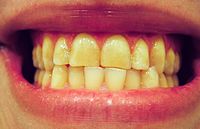
Photo from wikipedia
INTRODUCTION Parents' report is the most used method for the study of sleep bruxism (SB) in children, especially in research with large samples. However, there is no consensus about the… Click to show full abstract
INTRODUCTION Parents' report is the most used method for the study of sleep bruxism (SB) in children, especially in research with large samples. However, there is no consensus about the questions used to assess SB, what may difficult the comparisons between studies. OBJECTIVE The aim of this research was to evaluate the agreement between two different approaches to assess possible sleep bruxism (PSB) in children using parents' report. METHODS This cross-sectional study was conducted with 201 parents/caregivers. Prior to the questionnaire completion, all participants received a standard explanation of SB concept. Subsequently, the parents/caregivers answered a general question (GQ) and a frequency-time question (FTQ) about SB, and the answers were compared. RESULTS The majority of the participants were the children's mothers (73%) and the childrens mean age was 7.5 years (SD: 2.25). PSB frequency in children did not differ statistically through the two questions [GQ: 30.7% (CI95%: 24.2 - 37.1) and FTQ: 26.6% (CI95%: 20.4 - 32.8)], and an almost perfect agreement was observed between the answers (kp=0.812). Nevertheless, the FTQ showed a more coherent relation with the factors already recognized as associated with childhood bruxism than GQ. CONCLUSIONS Different approaches result in similar PSB frequency, however, they show different ability to identify PSB associated factors and suggest the need of questions including frequency and time in further studies.
Journal Title: Sleep science
Year Published: 2017
Link to full text (if available)
Share on Social Media: Sign Up to like & get
recommendations!